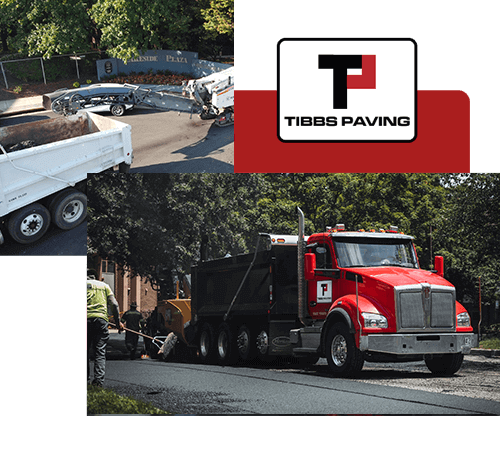Tibbspaving

News & Events
Tibbspaving
The Power Of Parking Lots
Debby Garbato / 09-02-2021
Today, parking lots are interactive areas with amenities that generate profits, lure consumers into stores and/or increase the duration of visits. Parking lot perks can include everything from dedicated pickup areas for online orders to electric car-charging stations, WiFi, outdoor seating and dog walk areas. Retailers also use lots for community events and seasonal merchandising events.
“It’s about thinking outside the four walls about how to generate additional sales inside, and retailers are pushing the envelope,” says Gary Fields, VP operations, West Coast at Jacksonville, Fla.-based Regency Centers, an owner of 406 shopping centers, 80% of which are anchored by grocers.
The biggest impact on parking lot activities occurred as a result of the pandemic. There was exponential growth of grocery pickup services as shoppers avoided entering physical stores. In early 2020, only 6.6% of major retailers offered grocery pickup, but by early 2021, that figure had risen to 50.7%, according to Chicago-based Digital Commerce 360. Among shoppers, 75% have used curbside pickup over the past six months.
Hy-Vee’s online transactions quadrupled during the pandemic’s first few weeks, making parking lots a destination, according to Dawn E. Buzynski, director, strategic communications at the West Des Moines, Iowa-based grocer. “Parking areas became a vital part of business as many customers ordered groceries online.”
At Boise, Idaho-based Albertsons Cos., digital sales increased 258% during its most recent fiscal year and its service, branded as Drive Up & Go, was the “fastest-growing segment and highlighted the importance of parking lots,” says a company representative.
Signage Solutions
Rapid expansion of curbside pickup and other “extras” has created navigational challenges. If not organized and managed properly, these multi-use areas can generate confusion, congestion and dangerous scenarios.
“It used to be that you could go to the grocery store and know the traffic pattern,” notes Bill Yankek, CEO of facilities management trade organization ConnexFM, based in Irving, Texas. “But it’s changed. You have a line of cars at curbside pickup and hundreds of people walking across the lot. If the parking lot isn’t functional and signage isn’t clear, you can have a mess. It’s never been more important for lots to be safe, clean and accessible.”
Grocers are bullish about finding additional opportunities just outside their box. “As the digital experience continues evolving, we anticipate increased parking lot opportunities that will enhance shoppers’ overall experience,” says the Albertsons rep.
In addition to identifying pickup areas, signage can help shoppers quickly navigate the entire digital transaction. “Signage is especially important to ensure customers can clearly identify Drive Up & Go areas and corresponding phone number signage for store pickups,” says the Albertsons rep.
Erecting more signage can be time-consuming and expensive, and further disrupts traffic flow. Some communities require permits. Also, signs are frequently damaged by careless drivers.
FlexPost Inc. solves those challenges with a product that uses crash-proof bollards to support customized signs. Installation involves affixing a steel base to the parking lot with four bolts. A heavy-duty concealed spring attaches the base to the pole. When hit by clumsy drivers, the sturdy product simply pops back up.
“We’re not doing serious drilling, so there’s little resistance from property owners,” says John DeYoung, FlexPost’s general manager. The Holland, Mich.-based company also offers a version with a portable base for temporary use. An interactive design tool allows retail executives to meet online to collaborate on signs’ custom graphics, colors and other elements.
Three years ago, Lakeland, Fla.-based Publix Super Markets began using FlexPost’s products in curbside pickup areas. When COVID-19 hit, FlexPost’s ability to install signs quickly made business explode. “Grocery became a question mark for many,” recounts DeYoung. “The ability to pick groceries up was very real during the pandemic. People needed to find curbside pickup. Signposts can be installed within a half-hour. Within eight hours, we set three stores for one retailer.”
For some chains, expanding online pickup areas has required more than new signage. Hy-Vee moved the pickup space from curbside to an area where it would interfere less with traffic. The grocer erected storage structures in these areas that hold orders awaiting pickup. Stores have eight to 12 pickup lanes, and capacity can be expanded as needed.
“We needed a better way for customers to pick up groceries that increased capacity, enhanced delivery, and was convenient and safe for customers and employees,” explains Buzynski. “This has boosted efficiency and ensures a smooth pickup experience.”
Some retailers lease or purchase adjacent space to expand pickup areas or maintain traffic flow. “This isn’t uncommon,” says the Albertsons rep. “We design pickup areas that sit seamlessly alongside traditional in-store shoppers without interruption.”
More Electric Cars
While electric vehicles (EV) aren’t yet cramming highways, they’re becoming a reality. According to Danville, Calif.-based EVAdoption, EVs will represent about 3.4% of new car sales in 2021 and grow to 29.5% by 2030. A key sales driver has been the growing number of EV-charging stations. In 2018, there were 64,000 nationwide, according to the Alternative Fuels Data Center, in Washington, D.C., and Miami-based consulting firm InsideEVs. By 2020, there were about 90,000.
Many major food retailers are offering this service in parking lots. It creates a double revenue stream: the customer pays for the charge and usually shops during the process.
Regency Centers offered EV charging at 50 of its centers in 2019, but that figure has grown to 82, and plans call for further expansion.
“It’s not just for a niche subset,” says Fields. “A retailer may say, ‘That’s not my customer.’ Well, there’s growth in EV.”
Hy-Vee, Walmart, Sam’s Club, Target, Albertsons, Kroger, Publix, Whole Foods Market and Trader Joe’s are among the food and consumables retailers offering EV charging.
Despite the benefits, charging stations and online pickup areas can reduce the number of parking spaces available to shoppers. This can be problematic in small or very busy lots, particularly if employees aren’t parking in allocated areas, or “poachers” from neighboring businesses are using the spaces.
Glide PARCS, a digital tracking system from New Orleans-based Premium Parking, uses a handheld device that automatically scans license plates while an employee strolls the parking lot. A second product, Glide Eye LPR, scans plates at lot entrances and exits. Results allow retailers to identify cars that have overstayed their welcome or are repeatedly parking illegally. The retailer can then enact a corrective action, be it a friendly warning or a less friendly boot or tow. License plate data can even be searched for stolen cars or during Amber Alerts.
“Retailers can identify problems,” asserts Ben Montgomery, president of Premium Parking and board director of the National Parking Association. “People rarely park in handicapped or pregnant-mother parking. The biggest problem is poaching.” Business, he adds, is growing 50% annually. Target is among retailers using the service.
The Whole Picture
Not all parking lot perks directly generate revenue, but they drive traffic. Albertsons established COVID-19 vaccination centers in some lots. For its part, Walmart has long used parking lots for health fairs, festivals and other events. Last summer, when most movie theaters were shuttered due to the pandemic, it partnered with the Tribeca Film Festival to show free drive-in movies in the lots of 160 stores. The family-friendly film lineup included “Friday Night Lights,” “The Karate Kid” and “E.T.”
With consumers spending more time in parking lots, retailers are paying more attention to how lots look from a maintenance, cleanliness and aesthetic perspective.
“A parking lot is the first thing anyone sees,” notes Fields. “Individually, trash cans and planters are no big deal, but all together, everything is a big deal. Now they’re more important.”
Source: ProgressiveGrocer.com

Tibbspaving
FREE Estimate
To receive a free estimate, please give us a call or complete this form.
Thank you!






